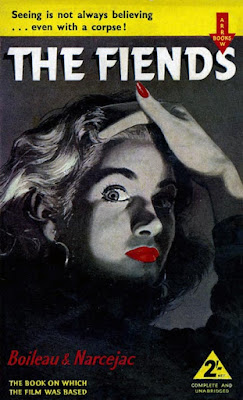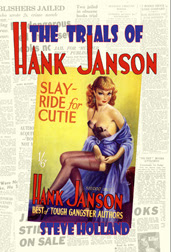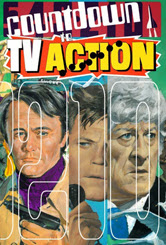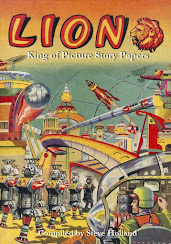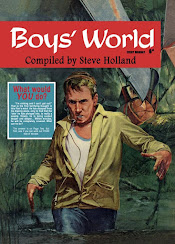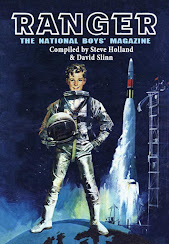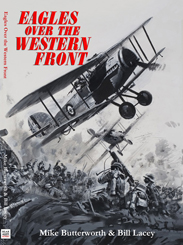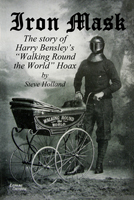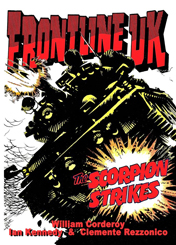I've just written a 115-word piece of filler about chicken pops—chicken breast in fried breadcrumbs—and I'm about to copy edit a short piece about whether it is commercially more sensible to refurbish a kitchen or scrap the old one and start from scratch. Welcome to the exciting world of editing!
The weary tone isn't due to overwork, just frustration. I'm pottering around doing little bits of filler that probably won't be used but which I need to have to hand just in case one of the features doesn't turn up. I had just such a situation last month where some last minute changes had to be made to the contents and I thought I'd spend some time making sure that there wouldn't be a hole this time around.
Sensible as that sounds, it's also the source of the frustration: I know that it's very unlikely that what I'm working on will ever see the light of day. We theme each section of each issue, so what I'm writing now will have no relevance to next issue's topic... so I can't just bump the material to next month. I have to scrap it entirely. Last month it was around 6,000 words, although quite a lot of that we were able to put online. This month it's mostly product filler which isn't much use for the website.
So I'm feeling a little frustrated as I'm finding there's precious little time at the moment to do any other writing. I've started doing some of the work I need to about British reprints of American magazines and American magazine imports and the first little bit should appear on Bear Alley next week, but the going is slow and it's not going to get any faster for a couple of months at least as next month's Hotel Business is a show issue with more pages and the one after that has a shorter deadline as we try to pull a little ahead before Christmas wrecks everybody's deadlines (I know... it seems like a long way to go, but in magazine terms it's only a few issues).
This week's random scans... as I'm thinking of those old "mushroom jungle" paperbacks at the moment, I thought I'd find some good girl art covers and found the following amongst the output of Hamilton & Co. They produced a slew of gangster novels in 1950-51 that, in a lot of cases, have yet to be credited to their real authors. I've never had a chance to do any kind of style analysis on the books as they're so scarce. Another project for another day.
Three of these are unsigned but I've seen them credited to John Pollack. I have to confess that I'm not 100% certain that's the case. I can't see any reason he wouldn't sign them if they were his. The artist is very familiar—I'm sure it's the same guy who painted covers for Edwin Self. Compare it to the Pete Costello novel at the top of the column... it's surely the same artist.
The cover for Faust of the FBI I'm really not sure about.
Friday, July 31, 2015
Thursday, July 30, 2015
Commando issues 4831-4834
Commando issues on sale Thursday 30th July 2015
Commando No. 4831 – Flight Of The Furies
In 1939, confident young Pilot Officer Duncan Marlow fell foul of an obnoxious C.O. and was posted out of the way to Griffin Island — a small garrison off Africa’s West Coast.
Discipline was lax and the Governor was untrustworthy. He was on friendly terms with the Germans who were stationed nearby, even though War between both countries was all but inevitable. What was going on…?
Soon Duncan, aided by a down-at-heel fellow pilot, found himself fighting the enemy in old Fury bi-planes. He was determined to strike back!
Story: Steve Coombs
Art: Jaume Forns
Cover: Ian Kennedy
Commando No. 4832 – Terror Train
Not one of the men waiting in the darkness of that tunnel was unafraid. Each felt the fluttering in the stomach, the trembling of the hands that meant stark fear had taken over.
Were these a pack of cowards, then?
No. Every man present was a hero, brave and full of fight. Picked men — British Commandos and the cream of the French Resistance, the Maquis.
But they were waiting for a train with a deadly cargo, and each man knew that in a few seconds he might have an appointment with death!
Introduction
It’s hard to believe that this classic Commando book hails from nearly half a century ago. Somehow it almost seems timeless – practically like a blueprint for everything that these ‘War Stories In Pictures’ were, and still are, all about.
It’s beautifully illustrated, with a fantastically pulpy cover, and features great characters, thrills and action that never lets up. ‘Terror Train’ keeps on track, never going off the rails, right until the final word.
Reader Announcement – Attention Please: Commando would like to apologise for the late arrival of the train puns in the previous sentence.—Scott Montgomery, Deputy Editor
Story: Redbridge
Art: Martin
Cover: Lopez Espi
Originally Commando No 209 (April 1966), re-issued as no 851 (July 1974)
Commando No. 4833 – The Desert Duel
Captain Jimmy Ramsey and his maverick Special Raiding Force were used to doing their own thing — dangerous hit-and-run raids deep behind enemy lines.
So, during the battle of El Alamein in autumn 1942, when the Raiders were teamed with a Long Range Desert Group unit to capture an isolated German airfield, tensions mounted between the tough, hard-headed factions. Both the SRF and LRDG felt they could do the job better on their own.
They would have to stop clashing long enough to fight the real enemy!
Story: Ferg Handley
Art: Keith Page
Cover: Ian Kennedy
Commando No. 4834 – The Man Who Was Afraid
What makes a good fighter pilot? It’s mostly skill, and Charles Crombie had plenty of that. But it isn’t only skill — you also need to be able to fly through a hail of bullets and flak threatening to hack you out of the sky at any minute. And that was what Charles was afraid of.
Then he took to wearing an old coin around his neck. It was his lucky charm. As long as he had it with him, he knew no fear.
As long as he had it with him…
Introduction
You might be interested to know that the original working title for this story was ‘The Courage Is Inside’. Obviously, I wasn’t in the Commando office in 1977 when the script came in (I was aged 5 at the time). But I’m guessing that one of the reasons it wasn’t used is that although appropriate to the subject matter, it somehow just doesn’t seem ‘Commando-ish’ enough to go in front of Ian Kennedy’s dynamic cover montage.
The story’s a good one – even though it features the fairly well-used plot device of a lucky charm – and there’s a main character that we’re genuinely rooting for. And it is all brilliantly illustrated, as usual, by Gordon Livingstone.—Scott Montgomery, Deputy Editor
Story: Mclean
Art: George Livingstone
Cover: Ian Kennedy
Originally Commando No 1152 (August 1977), re-issued as No 2476 (June 1991)
Commando No. 4831 – Flight Of The Furies
In 1939, confident young Pilot Officer Duncan Marlow fell foul of an obnoxious C.O. and was posted out of the way to Griffin Island — a small garrison off Africa’s West Coast.
Discipline was lax and the Governor was untrustworthy. He was on friendly terms with the Germans who were stationed nearby, even though War between both countries was all but inevitable. What was going on…?
Soon Duncan, aided by a down-at-heel fellow pilot, found himself fighting the enemy in old Fury bi-planes. He was determined to strike back!
Story: Steve Coombs
Art: Jaume Forns
Cover: Ian Kennedy
Commando No. 4832 – Terror Train
Not one of the men waiting in the darkness of that tunnel was unafraid. Each felt the fluttering in the stomach, the trembling of the hands that meant stark fear had taken over.
Were these a pack of cowards, then?
No. Every man present was a hero, brave and full of fight. Picked men — British Commandos and the cream of the French Resistance, the Maquis.
But they were waiting for a train with a deadly cargo, and each man knew that in a few seconds he might have an appointment with death!
Introduction
It’s hard to believe that this classic Commando book hails from nearly half a century ago. Somehow it almost seems timeless – practically like a blueprint for everything that these ‘War Stories In Pictures’ were, and still are, all about.
It’s beautifully illustrated, with a fantastically pulpy cover, and features great characters, thrills and action that never lets up. ‘Terror Train’ keeps on track, never going off the rails, right until the final word.
Reader Announcement – Attention Please: Commando would like to apologise for the late arrival of the train puns in the previous sentence.—Scott Montgomery, Deputy Editor
Story: Redbridge
Art: Martin
Cover: Lopez Espi
Originally Commando No 209 (April 1966), re-issued as no 851 (July 1974)
Commando No. 4833 – The Desert Duel
Captain Jimmy Ramsey and his maverick Special Raiding Force were used to doing their own thing — dangerous hit-and-run raids deep behind enemy lines.
So, during the battle of El Alamein in autumn 1942, when the Raiders were teamed with a Long Range Desert Group unit to capture an isolated German airfield, tensions mounted between the tough, hard-headed factions. Both the SRF and LRDG felt they could do the job better on their own.
They would have to stop clashing long enough to fight the real enemy!
Story: Ferg Handley
Art: Keith Page
Cover: Ian Kennedy
Commando No. 4834 – The Man Who Was Afraid
What makes a good fighter pilot? It’s mostly skill, and Charles Crombie had plenty of that. But it isn’t only skill — you also need to be able to fly through a hail of bullets and flak threatening to hack you out of the sky at any minute. And that was what Charles was afraid of.
Then he took to wearing an old coin around his neck. It was his lucky charm. As long as he had it with him, he knew no fear.
As long as he had it with him…
Introduction
You might be interested to know that the original working title for this story was ‘The Courage Is Inside’. Obviously, I wasn’t in the Commando office in 1977 when the script came in (I was aged 5 at the time). But I’m guessing that one of the reasons it wasn’t used is that although appropriate to the subject matter, it somehow just doesn’t seem ‘Commando-ish’ enough to go in front of Ian Kennedy’s dynamic cover montage.
The story’s a good one – even though it features the fairly well-used plot device of a lucky charm – and there’s a main character that we’re genuinely rooting for. And it is all brilliantly illustrated, as usual, by Gordon Livingstone.—Scott Montgomery, Deputy Editor
Story: Mclean
Art: George Livingstone
Cover: Ian Kennedy
Originally Commando No 1152 (August 1977), re-issued as No 2476 (June 1991)
Wednesday, July 29, 2015
Ray Bradbury interview (1971)
From my scrapbook, here's an ancient interview with Ray Bradbury from issue 28 of Rex, the British men's magazine, undated but published around December 1971.
Tuesday, July 28, 2015
Robert Ludlum
Yet another obituary from the scrapbook. I love the Bourne movies. They gave the thriller a much needed kick up the pants after they had become too effects heavy—the last Pierce Brosnan Bond, for instance, was a disaster. I've enjoyed the revival of Bond with Daniel Craig and I'm looking forward to the latest outing, SPECTRE, which will hopefully not be spoiled by having an unutterably dumb central premise which spoiled an otherwise beautifully shot Skyfall.
Monday, July 27, 2015
James A. Michener
Another obituary from my scrapbook. James A. Michener wrote huge novels that never really appealed to me, but they clearly appealed to some. I do find the descriptions of his books in the Daily Telegraph obituary hilarious: "Alaska (1980) begins with a family of mastodons and devotes 100 pages to the titanic life history of a sock-eyed salmon." Now you see why I thought the books were not for me!
Sunday, July 26, 2015
Saturday, July 25, 2015
Daphne Fielding
More scrapbook clippings, this from the Times back in 1997. Most authors have dull lives these days but my own research has uncovered quite a few writers who had lively backgrounds and were not above living their lives like it was a novel. I suspect I clipped this because of the mention of Duchess of Duke Street, but it might equally have been the mention of her husband, who translated a few books, including Bridge on the River Kwai by Pierre Boulle. Which gives me an excuse to run a few pictures...
The two books above were translated by Xan Fielding.
The two books above were translated by Xan Fielding.
Friday, July 24, 2015
Comic Cuts - 24 July 2015
I've been wearing my editorial hat this week, so there's little to report of note as my main research this week was into whether people were increasingly holidaying in the UK—and before it becomes a burning question in your life, the answer is yes, searches for hotels in seaside resorts jumped after the hot weather we had at the beginning of the month. You heard it here first.
On the side, I'm trying to find out more about the import of American magazines in the 1930s and the kind of numbers that arrived on these shores. It's proving difficult to get numbers, although I have found some examples that I might be able to use. My digging has also turned up the name of the guy who ran Atlas Publishing and Distribution, who had quite an important role in the history of British reprint editions of magazines and the distribution of comics in the UK, as well as publishing a few annuals. All will be revealed at some point.
While I'm still trying to maintain a level of research, I'm also trying to keep up with my exercise, although I seem to be stuck at the same weight for months on end. I didn't put on any weight during the winter (unlike the situation in 2014), but I've only lost a couple of pounds since March and I'd ideally like to be losing a pound a month.
That said, I'm still almost two stone lighter than I was two years ago, so... Yay! Go me!
I'm keeping up with the walks, which means that I'm watching the ever-changing, ever-developing landscape around my home. Although I'll walk in different directions—a poor attempt to keep things fresh—I do end up walking the same bits of roads every day or every other day. You become attuned to them and any changes seem more important than they probably are. For instance, a couple of months ago, the road around the corner had been deteriorating so badly that a hole had appeared near one of the drains. The drain cover was threatening to fall into the sewer below. Fixed now, but it took a couple of months.
I don't think I've ever been so aware of changes. Maybe it's something that comes with age. I don't remember noticing anything so trivial when I was a kid. They built a car park and shopping centre in the middle of Chelmsford... that I remember; I remember them building the new library and knocking down Hoffmans, but now I'm attuned to notices popping up all over the place:
My world has seemingly grown smaller over the years. I used to want to change our lives for the better. Nowadays, trying to figure out what the difference between a footpath and a footway is will fill most of one of my walks. Old age has crept up on me and turned me into a grumpy old man.
Our tomato count is currently: 9 Tumbling Toms, 5 Marmande Beefsteak and 8 Rosella Black Cherry. We have a second cucumber almost ready to pick and some beans starting to grow. For a pair who have always said we have the black finger of death rather than green fingers of gardners, Mel and I aren't doing too badly!
As I have been thinking about American magazine imports, I thought I'd use today's random scans to cover some American books that had British editions. Edward Ronns is today better remembered under his real name Edward S. Aarons, which he used for a long-running series of spy thrillers known as the "Assignment" series. His early hardboiled novels as Edward Ronns and Paul Ayres are little known these days, although they were often published in the hugely popular Gold Medal line of detective thrillers.
Two of the early covers here are based on the Gold Medal covers. The Decoy (originally Gold Medal 194) is an almost straight lift of the Barye Phillips original, but Passage of Terror (originally Gold Medal 217) has been extensively reworked from C. C. Beall's painting—which you can see at the top of this column—by a British artist.
Also below are a couple of others of slightly later vintage: the WDL (with a nice cover by Ron Smethurst) and the two Red Seals all date from 1960. The second has a signature, J. Coppin. Well, that's what it looks like to me (you can see it between the guy's legs).
Posts will probably be a little more patchy next week. We're heading towards the editorial deadline!
On the side, I'm trying to find out more about the import of American magazines in the 1930s and the kind of numbers that arrived on these shores. It's proving difficult to get numbers, although I have found some examples that I might be able to use. My digging has also turned up the name of the guy who ran Atlas Publishing and Distribution, who had quite an important role in the history of British reprint editions of magazines and the distribution of comics in the UK, as well as publishing a few annuals. All will be revealed at some point.
While I'm still trying to maintain a level of research, I'm also trying to keep up with my exercise, although I seem to be stuck at the same weight for months on end. I didn't put on any weight during the winter (unlike the situation in 2014), but I've only lost a couple of pounds since March and I'd ideally like to be losing a pound a month.
That said, I'm still almost two stone lighter than I was two years ago, so... Yay! Go me!
I'm keeping up with the walks, which means that I'm watching the ever-changing, ever-developing landscape around my home. Although I'll walk in different directions—a poor attempt to keep things fresh—I do end up walking the same bits of roads every day or every other day. You become attuned to them and any changes seem more important than they probably are. For instance, a couple of months ago, the road around the corner had been deteriorating so badly that a hole had appeared near one of the drains. The drain cover was threatening to fall into the sewer below. Fixed now, but it took a couple of months.
I don't think I've ever been so aware of changes. Maybe it's something that comes with age. I don't remember noticing anything so trivial when I was a kid. They built a car park and shopping centre in the middle of Chelmsford... that I remember; I remember them building the new library and knocking down Hoffmans, but now I'm attuned to notices popping up all over the place:
My world has seemingly grown smaller over the years. I used to want to change our lives for the better. Nowadays, trying to figure out what the difference between a footpath and a footway is will fill most of one of my walks. Old age has crept up on me and turned me into a grumpy old man.
Our tomato count is currently: 9 Tumbling Toms, 5 Marmande Beefsteak and 8 Rosella Black Cherry. We have a second cucumber almost ready to pick and some beans starting to grow. For a pair who have always said we have the black finger of death rather than green fingers of gardners, Mel and I aren't doing too badly!
As I have been thinking about American magazine imports, I thought I'd use today's random scans to cover some American books that had British editions. Edward Ronns is today better remembered under his real name Edward S. Aarons, which he used for a long-running series of spy thrillers known as the "Assignment" series. His early hardboiled novels as Edward Ronns and Paul Ayres are little known these days, although they were often published in the hugely popular Gold Medal line of detective thrillers.
Two of the early covers here are based on the Gold Medal covers. The Decoy (originally Gold Medal 194) is an almost straight lift of the Barye Phillips original, but Passage of Terror (originally Gold Medal 217) has been extensively reworked from C. C. Beall's painting—which you can see at the top of this column—by a British artist.
Also below are a couple of others of slightly later vintage: the WDL (with a nice cover by Ron Smethurst) and the two Red Seals all date from 1960. The second has a signature, J. Coppin. Well, that's what it looks like to me (you can see it between the guy's legs).
Posts will probably be a little more patchy next week. We're heading towards the editorial deadline!
Thursday, July 23, 2015
Tony van den Bergh
Another obituary from my scrapbook. Tony van den Bergh was not only an author but was a founder of Four Square Books, so this is a good excuse to run a few Four Square covers to brighten up the blog a little.
Wednesday, July 22, 2015
Caught in the Act: Gomer and others (1942) part 2
Prosecuting the case
for the County Solicitor, Mr. P. Prideaux stated by Ronald Gomer was
the ringleader of the three men charged. He held the post of organist
and choirmaster at a church and had been in the habit of befriending
other members of that church and bringing them to his house in Wimborne.
The earliest acquaintance was Harold Miller, who he befriended as far back as 1929. Gomer used to stay at Miller's parents' house in Winton when he went over to perform church duties at the weekend. Gomer also struck up acquaintance with three choir boys, befriended them, and asked them to come to his house.
Having no desire to see others get into trouble, Gomer made a statement in which he explained very fully his mode of life—how he came to commit the acts and the circumstances in which photographs were taken and letters written. Det.-Sgt. Fudge, of Wimborne, gave evidence that a search of Gomer's house had resulted in the discovery of 17 negatives, which were subsequently developed.
Gomer, later described as a man of artistic temperament, had been the organist and choirmaster at a Bournemouth church for 26 years. An only child, he had developed an early interest in music and he later earned a living teaching music and as an organist at local churches. He attributed his behaviour chiefly to "a sense of loneliness"—following the death of his parents in 1932 he had "more or less" lived alone and devoted himself to his interests in music, poetry and art. He had produced a masque at Wimborne in 1934 and published some small books of poetry.
He had known Francis (Frank) Hart for some years and they had taken their holidays together. Hart was born in Wimborne and had been employed as an assistant teacher to a local school where he remained for 15 years. Early in 1941, he became headmaster of a school in Dorchester and had given every satisfaction in his employment and spent many hours in work of national importance. Since boyhood he had been a member of the church choir and had been very active in matters connected with the church. For 15 years he held the position of a Scoutmaster.
Hart and Gomer visited each other's homes, playing cards. During the trial, Gomer was described as having done excellent work in connection with church matters, having been vestry clerk at a Wimborne church, chairman of a Scout troop at the Bournemouth church, and honorary secretary of the Wimburnians Association. Everyone spoke very highly of his energies in these directions.
However, at his trial, Mr. Justice Lawrence said that "I have no doubt that you, Gomer, were principally responsible," when passing sentence. Gomer, for his part, had said that when taking the photographs, that it was all treated as a joke. At the time of the acts, he said, their seriousness did not register in his mind and, of the 81 letters he had written to Harold Miller, he admitted that quite a number were indecent, but they were intended to be read only by Miller.
Miller, a native of Oldham, had worked as a clerk before joining the R.A.F. in 1940. He was an energetic worker connected with a Bournemouth church, being sacristan and Scoutmaster for the church troop. He had first met Gomer at the age of 17 but nothing had happened between them until 1938. Gomer had shown a keen interest in his welfare and, whilst unemployed for short periods, had received financial assistance from his friend. Commenting on the letters, Miller said he believed they were a "mere fabrication of a lonely mind."
Mr. J. B. Carson, for Gomer, described how the latter believed he suffered a "medical kink" and that he had expressed a desire to try and undergo some treatment to stop these tendencies. Carson asked for leniency in view of the fact that this was so much a medical case.
Mr. Justice Lawrence clearly disagreed and on 19 January 1942 sentenced Gomer to three years penal serviture. Hart and Miller each received six months imprisonment in the second division. At trial, all three had pleaded guilty.
The earliest acquaintance was Harold Miller, who he befriended as far back as 1929. Gomer used to stay at Miller's parents' house in Winton when he went over to perform church duties at the weekend. Gomer also struck up acquaintance with three choir boys, befriended them, and asked them to come to his house.
Having no desire to see others get into trouble, Gomer made a statement in which he explained very fully his mode of life—how he came to commit the acts and the circumstances in which photographs were taken and letters written. Det.-Sgt. Fudge, of Wimborne, gave evidence that a search of Gomer's house had resulted in the discovery of 17 negatives, which were subsequently developed.
Gomer, later described as a man of artistic temperament, had been the organist and choirmaster at a Bournemouth church for 26 years. An only child, he had developed an early interest in music and he later earned a living teaching music and as an organist at local churches. He attributed his behaviour chiefly to "a sense of loneliness"—following the death of his parents in 1932 he had "more or less" lived alone and devoted himself to his interests in music, poetry and art. He had produced a masque at Wimborne in 1934 and published some small books of poetry.
He had known Francis (Frank) Hart for some years and they had taken their holidays together. Hart was born in Wimborne and had been employed as an assistant teacher to a local school where he remained for 15 years. Early in 1941, he became headmaster of a school in Dorchester and had given every satisfaction in his employment and spent many hours in work of national importance. Since boyhood he had been a member of the church choir and had been very active in matters connected with the church. For 15 years he held the position of a Scoutmaster.
Hart and Gomer visited each other's homes, playing cards. During the trial, Gomer was described as having done excellent work in connection with church matters, having been vestry clerk at a Wimborne church, chairman of a Scout troop at the Bournemouth church, and honorary secretary of the Wimburnians Association. Everyone spoke very highly of his energies in these directions.
However, at his trial, Mr. Justice Lawrence said that "I have no doubt that you, Gomer, were principally responsible," when passing sentence. Gomer, for his part, had said that when taking the photographs, that it was all treated as a joke. At the time of the acts, he said, their seriousness did not register in his mind and, of the 81 letters he had written to Harold Miller, he admitted that quite a number were indecent, but they were intended to be read only by Miller.
Miller, a native of Oldham, had worked as a clerk before joining the R.A.F. in 1940. He was an energetic worker connected with a Bournemouth church, being sacristan and Scoutmaster for the church troop. He had first met Gomer at the age of 17 but nothing had happened between them until 1938. Gomer had shown a keen interest in his welfare and, whilst unemployed for short periods, had received financial assistance from his friend. Commenting on the letters, Miller said he believed they were a "mere fabrication of a lonely mind."
Mr. J. B. Carson, for Gomer, described how the latter believed he suffered a "medical kink" and that he had expressed a desire to try and undergo some treatment to stop these tendencies. Carson asked for leniency in view of the fact that this was so much a medical case.
Mr. Justice Lawrence clearly disagreed and on 19 January 1942 sentenced Gomer to three years penal serviture. Hart and Miller each received six months imprisonment in the second division. At trial, all three had pleaded guilty.
Tuesday, July 21, 2015
Caught in the Act: Gomer and others (1942) part 1
Despite the passage of seventy years, some of the details below might be strong for some. I'm posting this because it details the second and final case from 1942 involving obscene publications that resulted in a conviction and imprisonment in excess of 18 months. It helps chart the rise in prosecutions for indecent photos, although in many cases this was a secondary charge.
On Saturday, 19 December 1942, Francis John Thomas Hart (38), a schoolmaster of Blind Lane, Wimborne, was charged at a special Police Court at Wimborne with having committed an act of indecency.
On the same day, Ronald Gomer (52), a musician of 60 West Borough, Wimborne, was charged at Bournemouth Police Court with procuring a boy for the purpose of committing acts of indecency. According to Detective-Sergeant Jones, Gomer said, "I can't get away from it can I? It is right. It has only happened two or three times at the most. I should say several times. I don't want to tell lies about it."
Gomer was remanded as Inspector Fisher gave details of a second arrest in Wimborne and said it seemed desirable that Gomer should be handed over to the Wimborne police as both men lived in Wimborne. The Bench agreed. Following a second appearance at Bournemouth on Monday morning, Gomer was arrested by Detective-Sergeant C. Fudge at noon at Bournemouth Police Station and was brought up at the Police Court at Wimborne before Major Eric T. H. Hanbury-Tracy, OBE, that same afternoon.
Superintendent J. Dark, when applying for a remand in police custody until Thursday, said that he hoped by then to have arrested others involved. He also said that it was almost certain that other charges would be preferred. When the Magistrates' Clerk (Mr. M. J. Raymond) granted the remand, Gomer said: "I don't think I wish to make an application for bail."
Meanwhile, Hart, who had been arrested on the Friday evening, was also remanded until Thursday and his bail extended. A hearing was scheduled on that day for New Year's Day and whilst Hart's bail was renewed, Gomer remained in custody at Dorchester Gaol.
A third man was arrested on Boxing Day morning. Harold Miller (31), an aircraftman and native of Oldham who was living Edgehill Road, Windon, was arrested at Cleethorpe, Lincolnshire, and charged with having committed gross indecency with Gomer at Wimborne.
All three were brought before a special court on New Year's Day and again remanded, although Supt. Dark said that the charge against Gomer of gross indecency with Miller would not be proceeded with; instead they would be charged jointly. Bail was extended for Hart and Miller and Gomer was returned to Dorchester Gaol. The following Monday, all three were committed for trial at Dorset Assizes (at Dorchester).
The case against the three involved twelve charges. Ronald Gomer was charged with acts of indecency with Harold Miller; Francis Hart was charged with two acts of gross indecency with a boy, two indecent assaults on another boy, one indecent assault on a third boy, and three offences under the Post Office Act, namely the sending of indecent photographs, articles and an indecent communication in the form of a poem through the post. Both Miller and Hart were charged with gross indecency with Gomer.
At the close of the prosecution's case, Gomer pleaded guilty to the ten charges against him; Miller and Hart pleaded not guilty and reserved their defence.
Continued in our next.
On Saturday, 19 December 1942, Francis John Thomas Hart (38), a schoolmaster of Blind Lane, Wimborne, was charged at a special Police Court at Wimborne with having committed an act of indecency.
On the same day, Ronald Gomer (52), a musician of 60 West Borough, Wimborne, was charged at Bournemouth Police Court with procuring a boy for the purpose of committing acts of indecency. According to Detective-Sergeant Jones, Gomer said, "I can't get away from it can I? It is right. It has only happened two or three times at the most. I should say several times. I don't want to tell lies about it."
Gomer was remanded as Inspector Fisher gave details of a second arrest in Wimborne and said it seemed desirable that Gomer should be handed over to the Wimborne police as both men lived in Wimborne. The Bench agreed. Following a second appearance at Bournemouth on Monday morning, Gomer was arrested by Detective-Sergeant C. Fudge at noon at Bournemouth Police Station and was brought up at the Police Court at Wimborne before Major Eric T. H. Hanbury-Tracy, OBE, that same afternoon.
Superintendent J. Dark, when applying for a remand in police custody until Thursday, said that he hoped by then to have arrested others involved. He also said that it was almost certain that other charges would be preferred. When the Magistrates' Clerk (Mr. M. J. Raymond) granted the remand, Gomer said: "I don't think I wish to make an application for bail."
Meanwhile, Hart, who had been arrested on the Friday evening, was also remanded until Thursday and his bail extended. A hearing was scheduled on that day for New Year's Day and whilst Hart's bail was renewed, Gomer remained in custody at Dorchester Gaol.
A third man was arrested on Boxing Day morning. Harold Miller (31), an aircraftman and native of Oldham who was living Edgehill Road, Windon, was arrested at Cleethorpe, Lincolnshire, and charged with having committed gross indecency with Gomer at Wimborne.
All three were brought before a special court on New Year's Day and again remanded, although Supt. Dark said that the charge against Gomer of gross indecency with Miller would not be proceeded with; instead they would be charged jointly. Bail was extended for Hart and Miller and Gomer was returned to Dorchester Gaol. The following Monday, all three were committed for trial at Dorset Assizes (at Dorchester).
The case against the three involved twelve charges. Ronald Gomer was charged with acts of indecency with Harold Miller; Francis Hart was charged with two acts of gross indecency with a boy, two indecent assaults on another boy, one indecent assault on a third boy, and three offences under the Post Office Act, namely the sending of indecent photographs, articles and an indecent communication in the form of a poem through the post. Both Miller and Hart were charged with gross indecency with Gomer.
At the close of the prosecution's case, Gomer pleaded guilty to the ten charges against him; Miller and Hart pleaded not guilty and reserved their defence.
Continued in our next.
Monday, July 20, 2015
Thomas Narcejac
More from my scrapbook of paperwork... an obituary of French author Narcejac whose collaborative novel Les Diaboliques was filmed by Hitchcock as Vertigo. I've added a couple of covers to brighten things up.
Sunday, July 19, 2015
The House of Daemon
The House of Daemon is beautiful in many ways: the fictional house itself was designed by Bellini of Rome and had such extras as a hidden swimming pool under the lounge, although the breathtaking views out over the ocean are ruined by the broken windows, torn wallpaper and cobwebs that deck the main bedroom; it is also beautifully written by Alan Grant and John Wagner and stunningly drawn by Jose Ortiz.
House of Daemon was one of the comic strip highlights of the early issues of Eagle comic when it relaunched as a primarily photo story magazine, following on from that other Ortiz classic, 'The Tower King' (also available from Hibernia). The story's opening owed much to Poltergeist, which was released in the UK in September 1982, coinciding with the start of the story, but had debuted in the USA. in early June. Elliot Aldrich reveals that his wife Cassandra's family had been troubled by a Poltergeist when she was a child, making her sensitive to the supernatural influences in the dream house that he has bought her.
As they explore the house, a demonic presence makes itself felt and Elliott brings in an expert, parapsychologist Doctor Cormack, who brings with him a couple of students who set about trying to find the demon known as Daemon. Before long, they are all transported to a nightmare world that constantly reshapes itself
The key element to a horror story is: is it scary? And the answer is... not really. It has many of the same elements as a classic horror movie—the creepy creature trying to drag the beautiful young wife through the mirror, the tap that drips blood, doors that won't open—but in a comic aimed at kids, there's none of the graphic, visceral elements that a movie can rely on, no bumps or strange noises, no guiding soundtrack and no adrenaline rush excitement that reaches a crescendo. Quite the opposite, in fact—there's a seven day gap between episodes and in the four pages allotted to the story, it's difficult to build up the tension, let alone the heart rate, blood pressure and respiration increases that a movie can cause.
That said, it's still worth reading as a comic. Grant and Wagner made sure it was an inventive, fast-paced tale that confounded expectations—in the nightmare world of Daemon they are eaten by a worm and encounter American soldiers in a twisted nuclear war setting; even when they return to the real world, the floor dissolves into an ocean and... well, to say any more would be revealing too much. The big reveal is an unexpected twist, the characters reject sanctuary and risk eternal torture in order to return to their own world and the journey is not an easy one.
Jose Ortiz's artwork is superb throughout: he was a master of horror stories, as his years working for Warren proved, and he brought those well-honed skills to 'The House of Daemon'. So the strip might not be scary, but it is creepy and that, along with the quality of the writing and artwork, is enough to make this a little gem that's well worth rediscovering.
'The House of Daemon' is available from Hibernia Comics via their Comicsy website, price £9.00.
House of Daemon was one of the comic strip highlights of the early issues of Eagle comic when it relaunched as a primarily photo story magazine, following on from that other Ortiz classic, 'The Tower King' (also available from Hibernia). The story's opening owed much to Poltergeist, which was released in the UK in September 1982, coinciding with the start of the story, but had debuted in the USA. in early June. Elliot Aldrich reveals that his wife Cassandra's family had been troubled by a Poltergeist when she was a child, making her sensitive to the supernatural influences in the dream house that he has bought her.
As they explore the house, a demonic presence makes itself felt and Elliott brings in an expert, parapsychologist Doctor Cormack, who brings with him a couple of students who set about trying to find the demon known as Daemon. Before long, they are all transported to a nightmare world that constantly reshapes itself
The key element to a horror story is: is it scary? And the answer is... not really. It has many of the same elements as a classic horror movie—the creepy creature trying to drag the beautiful young wife through the mirror, the tap that drips blood, doors that won't open—but in a comic aimed at kids, there's none of the graphic, visceral elements that a movie can rely on, no bumps or strange noises, no guiding soundtrack and no adrenaline rush excitement that reaches a crescendo. Quite the opposite, in fact—there's a seven day gap between episodes and in the four pages allotted to the story, it's difficult to build up the tension, let alone the heart rate, blood pressure and respiration increases that a movie can cause.
That said, it's still worth reading as a comic. Grant and Wagner made sure it was an inventive, fast-paced tale that confounded expectations—in the nightmare world of Daemon they are eaten by a worm and encounter American soldiers in a twisted nuclear war setting; even when they return to the real world, the floor dissolves into an ocean and... well, to say any more would be revealing too much. The big reveal is an unexpected twist, the characters reject sanctuary and risk eternal torture in order to return to their own world and the journey is not an easy one.
Jose Ortiz's artwork is superb throughout: he was a master of horror stories, as his years working for Warren proved, and he brought those well-honed skills to 'The House of Daemon'. So the strip might not be scary, but it is creepy and that, along with the quality of the writing and artwork, is enough to make this a little gem that's well worth rediscovering.
'The House of Daemon' is available from Hibernia Comics via their Comicsy website, price £9.00.
Subscribe to:
Posts (Atom)























































